Proportion in Art Definition of Principle of Art Movement
Westwardhen we hear the word rhythm, we probably think of music. Beats. Tempos. Melodies. Rhythms that move u.s.. When it comes to rhythm in art the trounce changes a flake, and so to say, it comes in all different shapes, sizes, and colors. In this article we volition discuss and explore the question effectually, "What is rhythm in art?" with accompanying rhythm art examples.
Table of Contents
- one What Is Rhythm in Art?
- 2 The Five Types of Rhythm in Fine art
- 2.i Regular Rhythm
- two.2 Alternate Rhythm
- two.3 Flowing Rhythm
- 2.4 Progressive Rhythm
- two.five Random Rhythm
- 3 Summary of Rhythm in Art
- iv Principles of Fine art – Further Readings
- 5 Oftentimes Asked Questions
- 5.1 What Is Rhythm in Art?
- v.two What Are the Types of Rhythm in Art?
- five.three What Are the Principles of Art?
What Is Rhythm in Art?
First, we volition provide a cursory overview of what rhythm is and where it comes from in visual arts. Rhythm in fine art is part of several principles of fine art. These principles tin can too be called design principles, they are namely, balance, emphasis, movement, unity, harmony, diverseness, proportion, scale, and rhythm.
There are various definitions of the word "rhythm", i being, co-ordinate to the Merriam-Webster Online Dictionary, is that rhythm is "movement, fluctuation, or variation marked by the regular recurrence or natural flow of related elements".
The higher up rhythm definition points to its inherent pregnant, which is that rhythm is created past the repetition or pattern of diverse elements. In visual arts, this would be the fine art elements, which consist of colour, value, line, shapes, forms, space, and texture.
 Le Chahut (1889) by Georges Seurat; Georges Seurat, Public domain, via Wikimedia Commons
Le Chahut (1889) by Georges Seurat; Georges Seurat, Public domain, via Wikimedia Commons
A rhythm art instance would exist applying like colors next to one another in a sequence or an arrangement of shapes or lines that create a menses or movement to the artistic composition, and as a event, this flow or move creates the rhythm.
To distill the essence of rhythm tin also be challenging to achieve or apply in artwork as there are many ways to create it in fine art. This likewise allows artists of all modalities, be information technology drawing, graphic design, painting, or sculptures and installations, the ability and freedom of expression to play effectually with rhythm and apply it in many ways to create the desired effect for their artworks.
Artists can either choose to create a hyper-energized or dynamic artwork, something more calming and fluid, or something more orderly and geometrically structured. It will all be dependent on how the different art elements, mentioned above, are applied and combined.
 Rehearsal of the Pasdeloup Orchestra at the Cirque d'Hiver (1879-1880) by John Singer Sargent;John Vocalizer Sargent, Public domain, via Wikimedia Commons
Rehearsal of the Pasdeloup Orchestra at the Cirque d'Hiver (1879-1880) by John Singer Sargent;John Vocalizer Sargent, Public domain, via Wikimedia Commons
The 5 Types of Rhythm in Fine art
Information technology is important to annotation that some fine art sources provide 3 chief types of rhythm and other art sources provide five. Below we will discuss the five types of rhythm in art, which are also the techniques utilized to use this principle in a composition. Nosotros will also provide several rhythm art examples from different artists throughout art history.
Regular Rhythm
Permit us beginning with the regular rhythm in fine art, which is simply what its name suggests, regular. A regular rhythm is consistent with its motifs. Whether different art elements are utilized, for example, color, line, or shapes, these are arranged in even and consistent patterns. However, unremarkably like fine art elements or motifs are arranged to create regularity.
Some examples frequently used from the earth of sound include imagining the rhythm of a heartbeat, a clock, or a tap dripping. These are all regular and consistent.
With this, regular rhythm in fine art is characterized by simplicity and ease, recollect of cartoon repeating horizontal or vertical lines side by side to or on tiptop of one some other; evenly spaced, it volition create an even visual rhythm.
 On Lake Geneva: Mural with Rhythmic Shapes (1908) by Ferdinand Hodler;Ferdinand Hodler, Public domain, via Wikimedia Commons
On Lake Geneva: Mural with Rhythmic Shapes (1908) by Ferdinand Hodler;Ferdinand Hodler, Public domain, via Wikimedia Commons
Conversely, if there is too much of a regular rhythm in an art composition it can appear boring or as well repetitive. Withal, this can be countered past adding more than variety hither and there within the same composition.
An instance of this can be found in the oil painting Fall Plowing (1931) past the American artist Grant Woods. Here nosotros see in the middle of the composition a regular rhythm created by the large grass bundles on the plowed field besides equally the plow lines in the foreground of the limerick.
All the same, surrounding these are different lines from the surrounding hills, which create a different rhythm adding diverseness. This can too exist viewed equally a random rhythm example, which we volition hash out in more detail below.
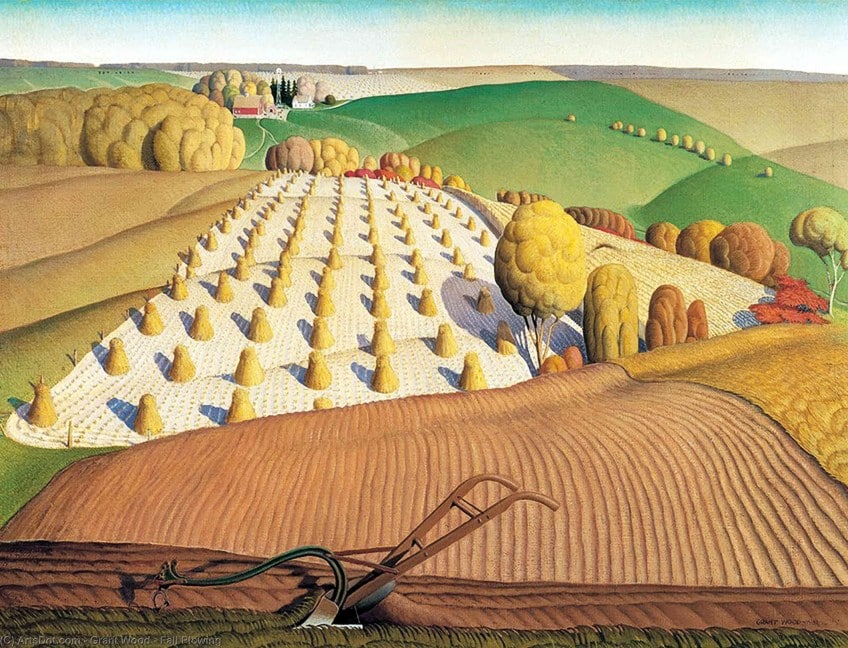 Fall Plowing (1931) by Grant Forest;Grant Woods, Public domain, via Wikimedia Commons
Fall Plowing (1931) by Grant Forest;Grant Woods, Public domain, via Wikimedia Commons
Several other regular rhythm art examples include The Four Trees (1891) by Claude Monet, which forms part of his Poplar Series (1981 to 1900). In this painting there are four copse along the banks of the Epte River, they appear evenly spaced and create consequent vertical lines in the composition.
Monet's other painting from this series is similar, for example, Poplars at the River Epte (1900), which depicts seven trees running in a line. What creates a regularity here is the similarity of the copse, which are also positioned close together and all in vertical lines.
 A Row of Poplar Copse Line the River Epte (1819) past Claude Monet;Claude Monet, Public domain, via Wikimedia Commons
A Row of Poplar Copse Line the River Epte (1819) past Claude Monet;Claude Monet, Public domain, via Wikimedia Commons
The American artist Donald Judd produced installations or "stacks" like Untitled (1967) and Untitled (1968), amidst others, which consists of rectangular shapes all every bit sized and positioned confronting a wall and spanning from the ceiling to the flooring; in that location are likewise equal distances betwixt the rectangular box shapes.
Judd'southward stacks create a consistent flow, so to say, up and down the wall space, creating a regular rhythm without any other surrounding rhythms or elements that change its flow. The stacks are also the aforementioned color, which adds to the consequent rhythm.
Alternating Rhythm
An alternating rhythm in fine art consists of more than one, ofttimes 2, different motifs arranged in a pattern. According to some fine art sources, an alternate rhythm in art is similar a regular rhythm, but with more intricacies, sometimes shapes are placed in dissimilar directions. A common example of an alternating rhythm in art is that of a chessboard with its blackness and white squares.
The motifs may vary in color or shape, or whatsoever other fine art chemical element, merely the result will give the limerick more character, meaning, and movement. It volition also create more variety and reduce potential plainness that may result from a regular rhythm.
According to some art sources, there are disadvantages to an alternating rhythm in art every bit information technology may besides require more attention to particular to convey it accurately, especially if it is created by paw, and if not applied properly it can potentially appear too busy or "cluttered".
Some rhythm art examples include the Surrealist/Op artist Thousand.C. Escher's Cadger (1942), in which we run into alternating lizard shapes in brown, black, and white, each molded aslope the other. While there are no evident gaps betwixt the lizard shapes the alternate colors and specific arrangement gives the limerick a unique rhythm that does not brand it appear also cluttered.
The Orphism creative person Robert Delaunay created numerous compositions in a diversity of colors and shapes that bordered on brainchild. With this Delaunay's artworks are filled with dynamism and motility, one instance is his oil on canvas Countless Rhythm (1934).
This painting is composed of circles and curved lines, otherwise also semi-circles, and running straight through the center is an implied direct line.
There is an alternating rhythm created between diverse elements here, for case, in the large black and white circles at that place are alternating colors bordering the elevation and lesser circles; the summit circle's left half is yellow, and the correct half is blue, while the bottom circles' left half is blue, and its right half is yellow.
Furthermore, the big black and white circles appear underneath the smaller, alternating in color, gray and blueish circles on top. These are further contrasted by the alternating colors of the thick line swirling through them creating semi-circles.
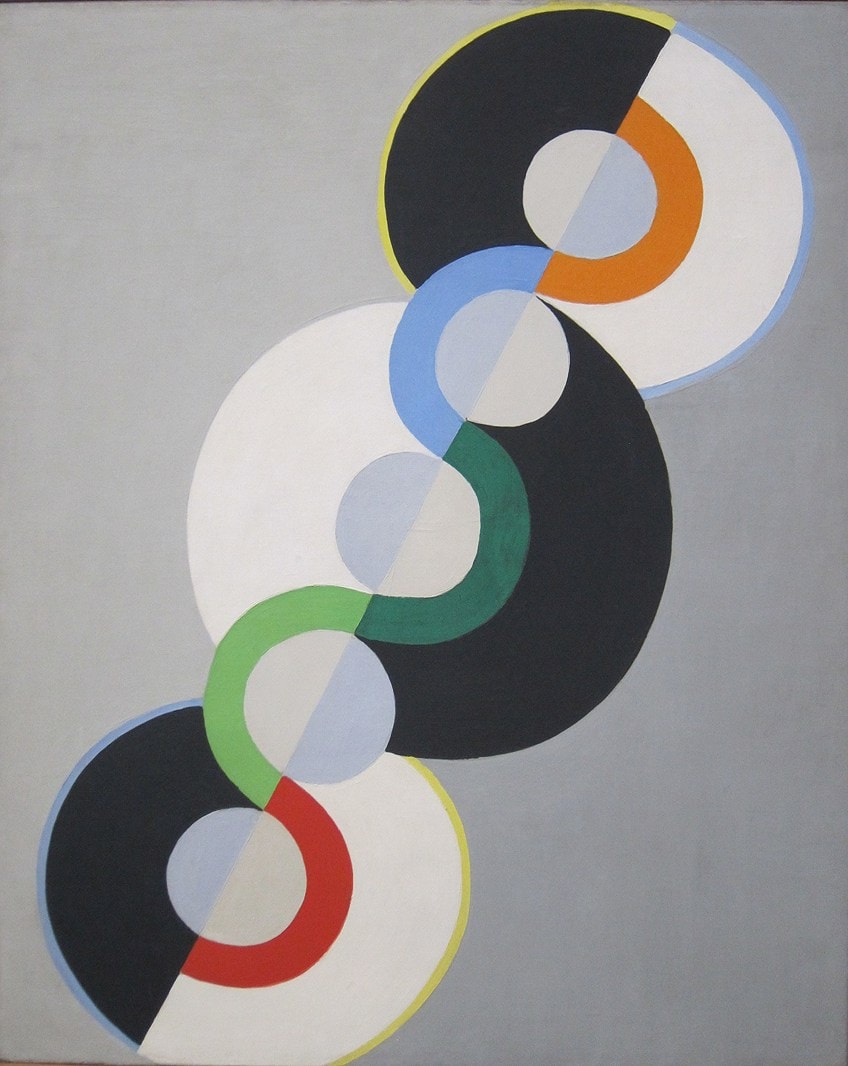 Endless Rhythm (1934) by Robert Delaunay;Robert Delaunay, CC0, via Wikimedia Commons
Endless Rhythm (1934) by Robert Delaunay;Robert Delaunay, CC0, via Wikimedia Commons
Flowing Rhythm
A flowing rhythm in art is when a pattern follows the "organic" patterns made by nature, which are typically circular or curved lines and shapes and often described as "undulating", which means rise and falling, commonly in the course of waves. Flowing rhythm in art provides the visual composition with more character and dynamism, particularly if a moving ridge is portrayed. Furthermore, the flowing rhythm provides a pathway for our gaze.
While the flowing rhythm in art is characterized more by art elements like curved lines and shapes, as mentioned above, other fine art elements can be applied to emphasize information technology like color, value, size, and so forth.
A famous flowing rhythm art instance is the Japanese woodblock print by Katsushika Hokusai, titled The Smashing Moving ridge off Kanagawa (1831). In this composition, we see a large wave to the left about to envelop the small boats on the ocean's surface. The big wave is surrounded by other smaller waves and curves that requite the entire composition a flowing rhythm and undoubtedly a dynamic move, which also evokes emotional aspects.
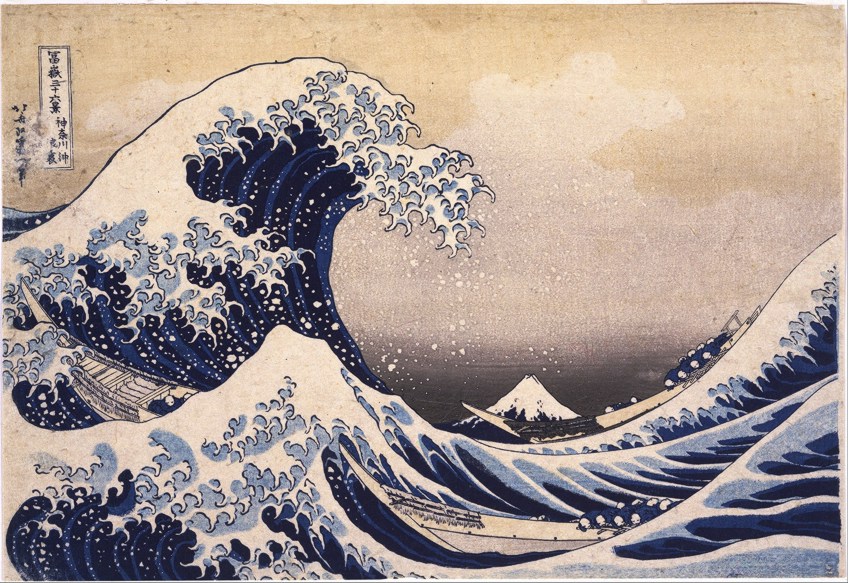 The Cracking Wave off Kanagawa (1831) by Katsushika Hokusai; Katsushika Hokusai, Public domain, via Wikimedia Commons
The Cracking Wave off Kanagawa (1831) by Katsushika Hokusai; Katsushika Hokusai, Public domain, via Wikimedia Commons
Another case includes The Scream (1893) past Edvard Munch, although here the flowing rhythm is created past the swirling brushstrokes evident in the sky and landscape surrounding the screaming figure standing on the bridge, who is besides painted in flowing brushstrokes. The entire composition is undulating, and the rhythm creates a strong emotive quality.
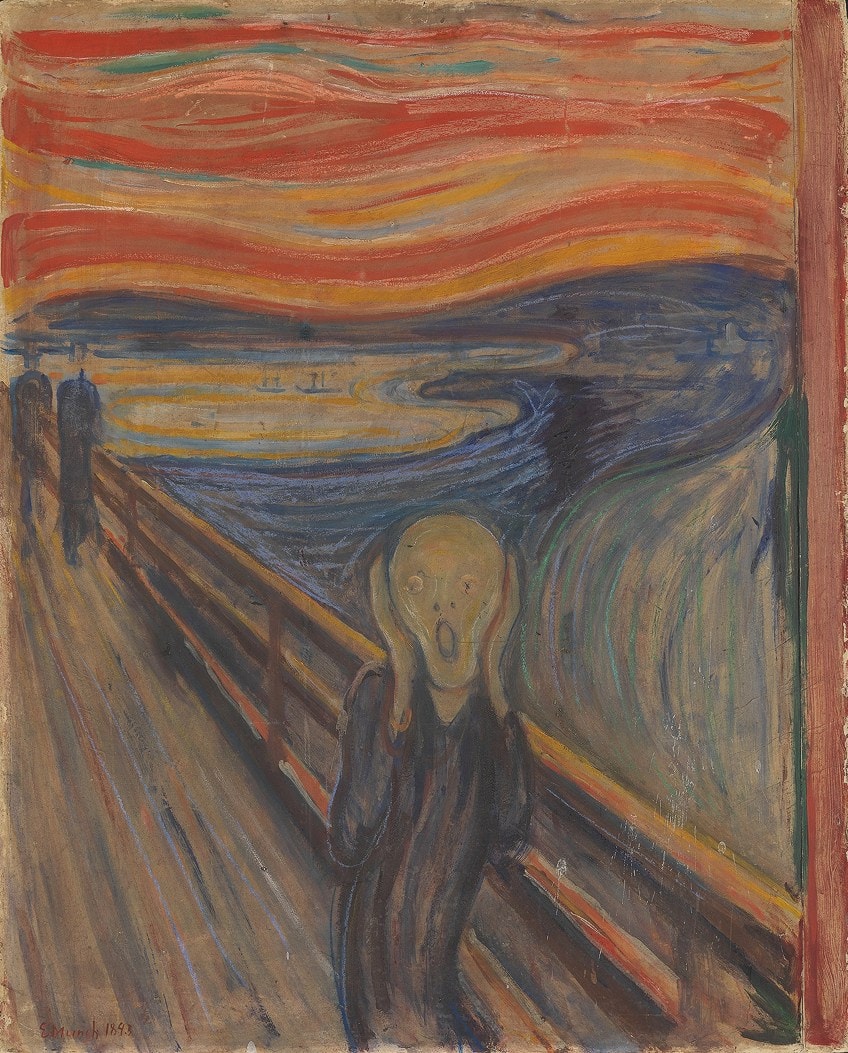 The Scream (1893) by Edvard Munch; Edvard Munch, Public domain, via Wikimedia Eatables
The Scream (1893) by Edvard Munch; Edvard Munch, Public domain, via Wikimedia Eatables
We run across similar emotive qualities evoked from a swirling landscape in one of the virtually famous paintings from the Dutch Vincent van Gogh, titled The Starry Night (1889). In this limerick, Van Gogh depicts a starry night sky in strong swirls of paint, the texture of the paint farther emphasizes its dynamism.
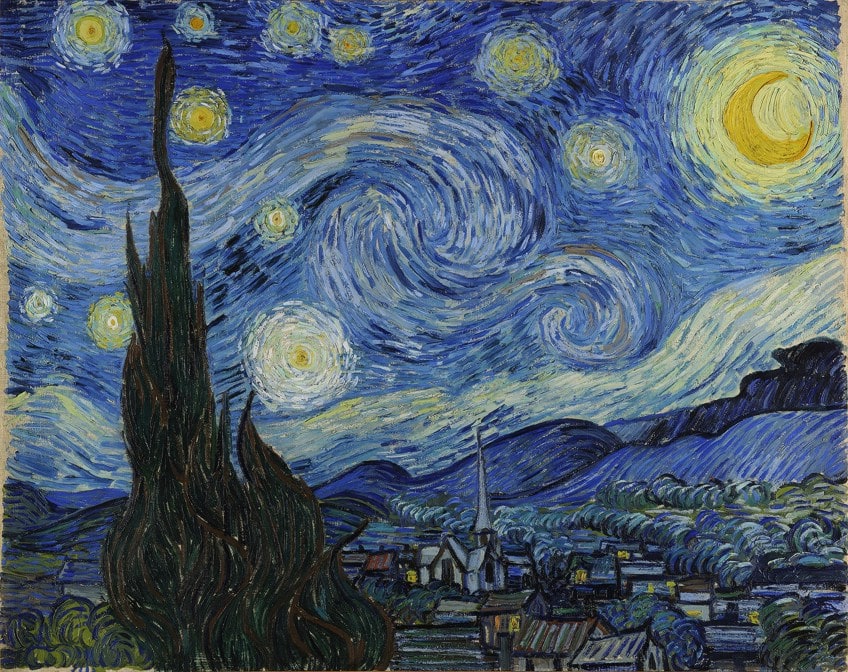 The Starry Night (1889) past Vincent van Gogh; Vincent van Gogh, Public domain, via Wikimedia Commons
The Starry Night (1889) past Vincent van Gogh; Vincent van Gogh, Public domain, via Wikimedia Commons
Progressive Rhythm
Progressive rhythm in art occurs when any art element, for example, color, shapes, or forms, bundled in a sequence or pattern is changed. The word progression implies an advancement or forward motility of either a series or sequence of objects or figures. Still, it can as well hateful that something advances or recedes in size in space.
Progression is demonstrated by how art elements are utilized in a limerick.
These tin can alter in size or shape, or they can remain the same but only be viewed from an angled perspective in space, which will requite them a progressive advent, otherwise, fine art elements can exist in different colors giving it the appearance of progression.
Progressive rhythm fine art examples of the above-mentioned ideas can include different shapes similar squares or rectangles placed in different consecutive sizes, for case, the famous Iii Flags (1958) by the American artist Jasper Johns.
In this painting, there are 3 American flags placed on peak of the other, however, each flag becomes larger in size every bit it receded into the background; the top flag is the smallest allowing u.s. to run across the other two behind information technology.
Some other example includes the X-ray of Nautilus Shell (c. 1910) by Edward Charles Le Grice, which is a clear illustration of how progressive rhythm unfolds; the vanquish's segments become larger from the inside out, and smaller vice versa.
Random Rhythm
Random rhythm in art refers to the random application of art elements; there is no order to how the sequences or patterns are placed in the limerick. This tin include well-nigh any art element or fine art principle combined with one another or utilized singularly. Although it might non appear ordered, sometimes it can be planned to appear disordered. Furthermore, it can be geometric, abstract, or more figurative subject matter.
Random rhythm in fine art can create more diversity in composition, leading our gaze hither and thither, keeping us always engaged. However, random rhythm in art can also pose challenges if it is not depicted accurately.
Some random rhythm art examples include the famous Abstract Expressionist Jackson Pollock and his large canvases of splashed and dripped paint. For example, Autumn Rhythm: Number thirty (1950), in which we meet various colors of paint splashed onto the canvass in what appears as lines, some are long, short, thick, thin, curved, twirled, and linear. There are also various dots of paint.
In Pollock's Blueish Poles (1952) we also run across streaks of paint covering the canvas and around 8 vertically linear streaks of paint spaced across the sheet. Pollock produced numerous of these types of paintings, also referred to as "all-over" or "activity" paintings. Some other mutual random rhythm in art example is Immature Corn (1931) by the American artist Grant Forest.
In this painting, we run across a landscape of expansive fields leading into the distance. There are different rhythms depicted in this composition, which makes information technology random.
The rhythm examples include the undulating hills and curved lines from the road, the line of the trees to the right, besides as the lines from the fields that mold along the smooth curves of the hills. These all appear flowing in their rhythm and there is also a regular rhythm depicted in the plowed field in the foreground, the eye footing, and far background.
Undergrowth with Two Figures (1890) by Vincent van Gogh depicts different rhythms, for example, the repeated rows of copse leading into the groundwork suggests a progressive and regular rhythm, it also creates the outcome of stillness with its consistency and structured arrangement.
When we look at the grass, at that place appears to be more than movement, an energetic rhythm is created by how van Gogh utilizes texture here likewise every bit short and inclement brushstrokes. Additionally, more color is utilized for the flowers and bushes, the bottom area is filled, all giving information technology a livelier feeling compared to the monotones of the trees also as the larger areas of space betwixt them.
 Undergrowth with 2 Figures (1890) by Vincent van Gogh; Vincent van Gogh, Public domain, via Wikimedia Commons
Undergrowth with 2 Figures (1890) by Vincent van Gogh; Vincent van Gogh, Public domain, via Wikimedia Commons
Summary of Rhythm in Art
| Rhythm in Art Techniques | Characteristics | Rhythm art examples |
| Regular Rhythm | Consistent repetitions or patterns of art elements. | Fall Plowing (1931) past Grant Woods |
| Alternate Rhythm | Different motifs are arranged in alternating patterns or sequences. | Lizard (1942) by Thousand.C. Escher |
| Flowing Rhythm | Follows more than curved, circular, and fluid forms, often taken from "organic" forms in nature. | The Great Wave off Kanagawa (1831) by Katsushika Hokusai |
| Progressive Rhythm | A pattern or sequence of art elements irresolute in shape or size, sometimes it diminishes in size or enlarges in size. | Three Flags (1958) by Jasper Johns |
| Random Rhythm | Uses one or more different types of rhythms in art compositions. | Autumn Rhythm: Number 30 (1950) by Jackson Pollock |
In the article above we discussed what rhythm in art is, as one of the principles of art, rhythm provides a visual composition with a sense of dynamism. It tin can give an artwork character and lead our gaze towards the focal point, several focal points, or no focal points, simply just the entire composition.
Rhythm in fine art is depicted past a series or sequence of patterns that are oftentimes repeated, these consist of art elements like color, line, shape, course, texture, and space. There are also different types of rhythms in art that we explored, namely regular, alternating, flowing, progressive, and random.
Principles of Fine art – Farther Readings
- Principles of Art master article
- Movement in Art
- Emphasis in Art
- Unity in Art
- Texture in Art
- Proportion in Art
- Residue in Art
- Harmony in Fine art
Rhythm in art adds variety and variety to a visual art limerick, without a sense of rhythm the artwork would be about lifeless and lack a trounce. As it is in music besides, rhythm provides a foundation of movement or motion that can be practical in many ways, just similar a song can exist played in many different tunes, and it can appear fast or irksome-moving.
Frequently Asked Questions
What Is Rhythm in Art?
Rhythm in art is one of the principles of art that gives an art composition motility, motility, or dynamism. It leads our gaze to the main focal point or several focal points in an artwork. Rhythm can too be depicted with several techniques. Depending on how it is depicted it can brand an artwork livelier, calm, or energized.
What Are the Types of Rhythm in Fine art?
There are v types of rhythm in art, namely, regular rhythm, alternate rhythm, flowing rhythm, progressive rhythm, and random rhythm, which can be a combination of any of the to a higher place types of rhythms.
What Are the Principles of Art?
The principles of art, namely, remainder, harmony, variety, rhythm, motion, accent, proportion, scale, and unity are described as "principles of organization". These are like guiding rules that determine how artists or designers can use art elements, which are color, value, line, texture, shape, grade, and space, in a composition. Post-obit the principles of art in artworks will ensure information technology is a unified whole where all the necessary elements work together.
Source: https://artincontext.org/rhythm-in-art/
0 Response to "Proportion in Art Definition of Principle of Art Movement"
Post a Comment